Located between the two oldest civilizations in the world, china and India, the Tibetan plateau owes its sense of mystery to its separation from the world by the Himalayas, its checkered history saw many dynasties flourish and collapse and wars that divided territories. Often referred to as the land of Buddhism, Tibet’s exoticism is further enhanced by numerous myths and curious customs. Endless fascinating legends inspire millions of people to visit this land at least once in a lifetime.
[rpi]
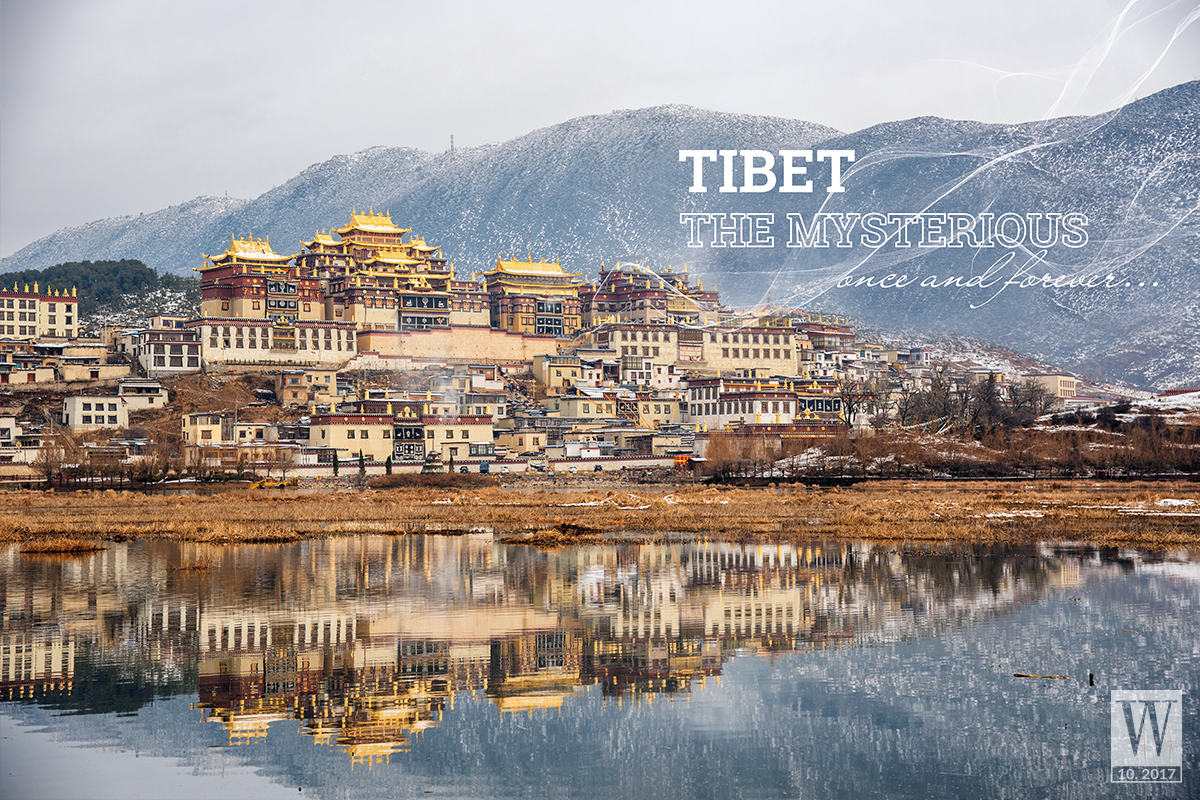
LHASA – THE HOLY CITY
From the plane, Tibet easily overwhelms all those who first come here with its magnificent natural scenery, white clouds floating over snow-covered mountains and closer to the foot of the mountains, typical Tibetan houses nestled by the river. Tibet’s Lhasa Gongga Airport lies in a valley where Mother River, the largest river in Tibet flows. Flying in at 7pm, I witnessed the sun still shining brightly in a clear sky. In the summer, the temperature here is just above 20°C so the weather is very pleasant. When we landed at the airport, like other travelers, I was given a white scarf symbolizing good luck and peace.
About 1 hour by car from the airport, Lhasa is located at an altitude of 3,650 metres above sea level. It is quite modern and different from how I imagined, with many tall buildings, cars, wide roads and regulated traffic. Tibet has its own language so the signs are often in bilingual Tibetan-Chinese. After checking in at the hotel, I was advised to wash my face and cleanse with only a wet towel, then take a rest to avoid altitude sickness.
After reading many memoirs about Tibet, I knew that several centuries ago, hundreds of thousands people crossed the mountains to travel to Lhasa – the capital of Tibet despite rainstorms, blizzard winds and dire conditions. For Buddhist devotees, Lhasa has an irreplaceable place in their hearts.
DREPUNG – THE LARGEST MONASTERY IN TIBET
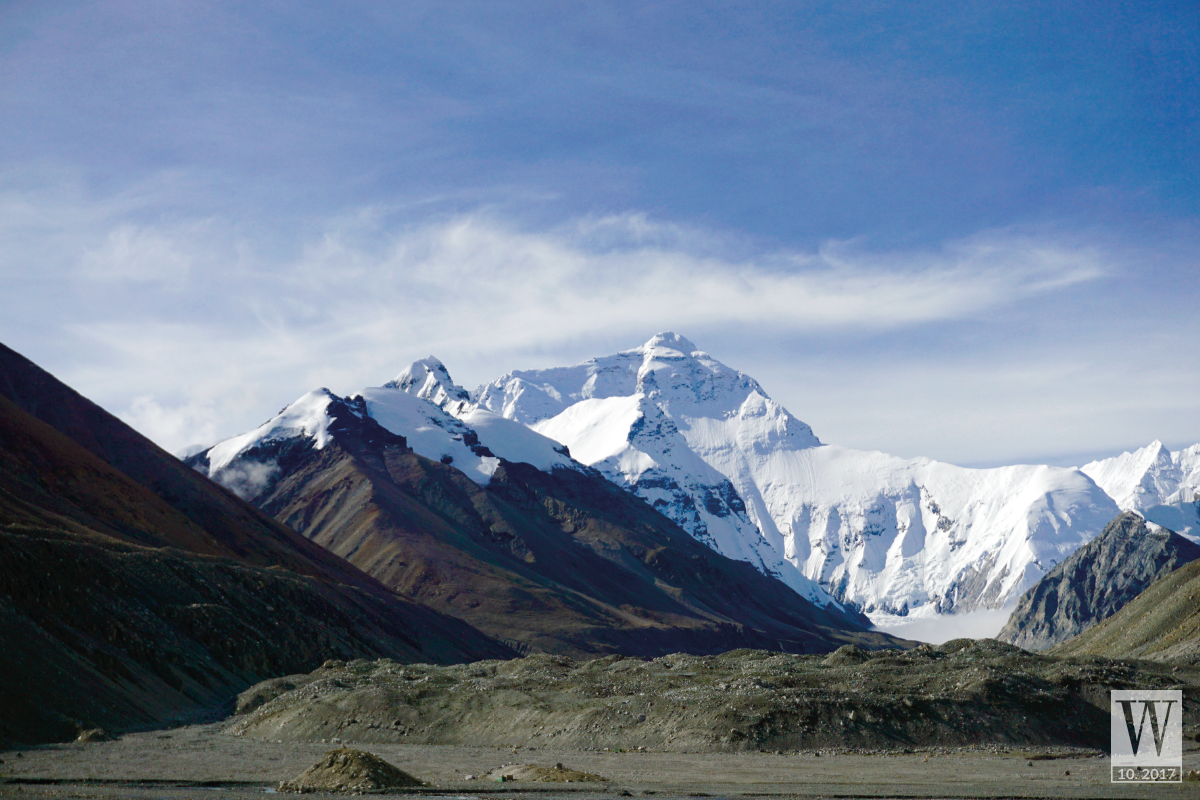
Lying on the immense and majestic Gebeiwoze Mountain, being called, “a mound of rice” by the locals, which implies a peaceful land that brings fullness to Tibetan, Drepung Monastery was built in 1416 by a disciple of Lama Tsongkhapa (The founder of the Buddhist school – Vajrayana that exists to this day as the largest and still official religion in Tibet).
Before going inside, I stopped behind the ticket gate to buy a bunch of azaleas with the hope that the smoke of burned azaleas would send my prayer to Buddha. Bronze chakras are found everywhere on the way to the monastery’s main quarters, some are operated by manual power, some by waterpower. To pray like the true Tibetan, touch the bottom of the chakra and turn clockwise.
In Tibet, Drepung is the most sacred monastery because it’s been home to most of the Dalai Lamas here. This monastery is where more than 10,000 Tibetan monks are studying. It was built on the slopes in an area of 20 hectares, so it would take several days for you to visit the whole monastery.The must-see place here is the hall, where there are many large Buddha statues and where hundreds of monks in blood-red robes chant under dim light in a limited space. In addition, there are small, humble and sacred places for the Dalai Lama living and working in the monastery. If you love arts, the Thangka paintings are sure to satisfy with colors from natural materials which will not fade for 3-4 centuries. In addition, Drepung is a place preserving the 2nd, 3rd and 4th Dalai Lama’s stupa tombs. On the way from one area to another, you will see the great sculptures on the mountain slope…
POTALA PALACE – THE ARCHITECTURAL WONDER
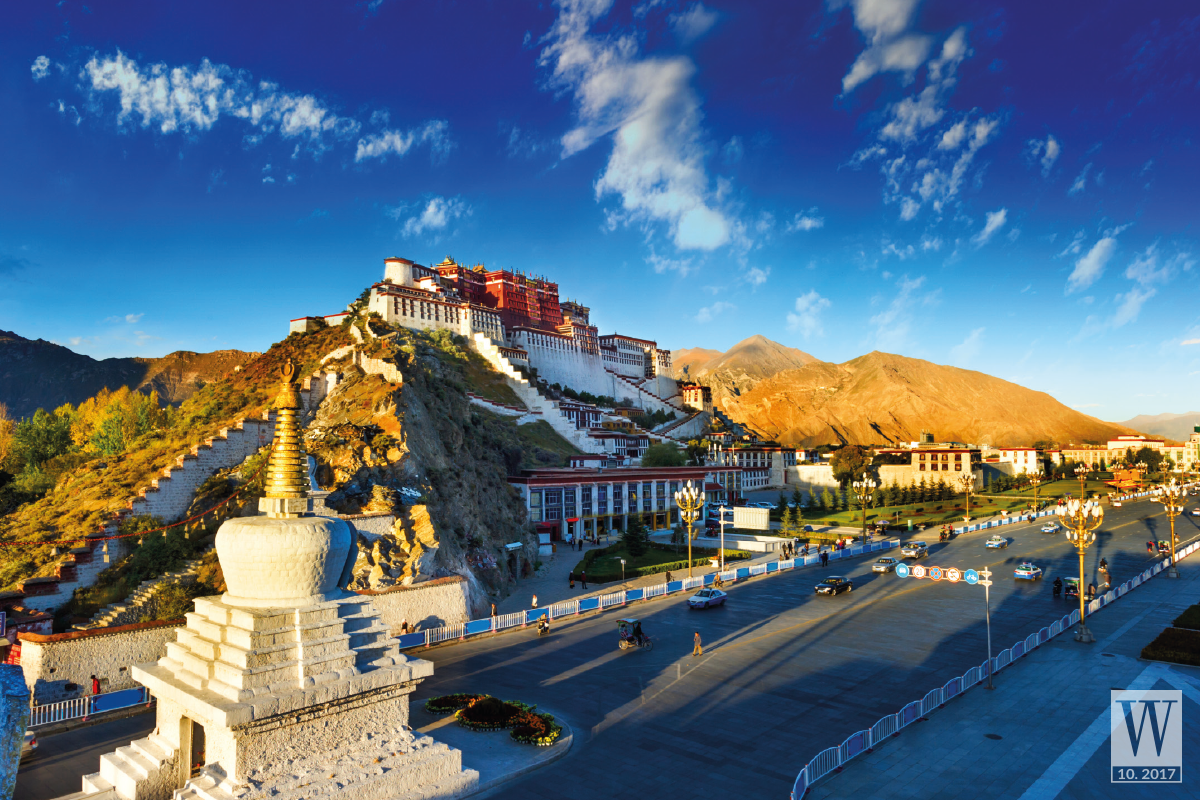
Potala Palace is Tibet’s most famous destination and considered an architectural wonder of the world as wel as recognized by UNESCO as a World Heritage Site. It is not always possible to visit the Potala, but depending on daily activities, the authorities can allow visitors to go inside at a certain time slot. The square in front of the palace is where you can admire the panoramic view of Potala under the clear blue sky. The first impression is the architecture. The entire palace stretches over a low mountain, with a height of 117 metres and 13 floors. The palace has two main areas, the White Palace for political activities and the Red Palace devoted to religious studying where the Dalai Lama and the Lama live. The small yellow houses are for study.
The amazing thing is that this 13-floor palace with thousands of rooms was built four centuries ago from stone, wood, mud, and soil but still exists today. In the past I’ve admired the majesty of Angkor Wat, and been amazed by the royal palace built on Lion Rock, Sigiriya in Sri Lanka. However, I now bow my head in admiration to the efforts of the Tibetan predecessors. It is interesting that the walls of the palace comprise two materials, the stones inside and the countless tamarisk bushes intertwined with each other. The floors are made of loose soil and rocks, without any added materials but it is still very stable and waterproof, warm in the winter and cool in the summer. Women were those who beat the soil and rocks to make the floor. Of course, there are crossbeams underneath the soil and rocks to withstand the tremendous force from above.
Climbing the palace’s 13 levels under the sun at a height of nearly 3,700 metres was a real challenge. As many have well noted, in Tibet, breathing is also a challenge. However, with respect to the Buddhist faith, everyone encouraged each other to climb to the top and no one gave up. Each room here is a miniature museum of Buddhist history, art and culture. Instead of reciting “Namo Amitabha Buddha”, here we will use a Sanskrit phrase “Om Mani Padme Hum”, the six syllables of this mantra represent the purification of the six realms of existence.
Incredibly, we got a rare opportunity to worship at the stupa tombs of eight Dalai Lama, including the 5th, 7th, 8th, 9th, 10th, 11th, 12th, and 13th Dalai Lama. The 6th Dalai Lama had the most different life, and somehow his body wasn’t found after he died. The 14th Dalai Lama had been living in exile in India since 1959 and he may be the last Dalai Lama of this mysterious country. In Tibet, the Dalai Lama is not elected by the government or the people like other political institutions, they are actually a reincarnation of the previous Dalai Lama to become the spiritual leader of the Tibetans. The stupa tombs of the 5th Dalai Lama, due to his greatest contribution, is the largest tomb made of 3,721 kilograms of gold and decorated with many precious stones, including one of white jade. When here, you should not miss a moment to admire the Potala at night with its fanciful sparkling beauty.
THE JOKHANG TEMPLE
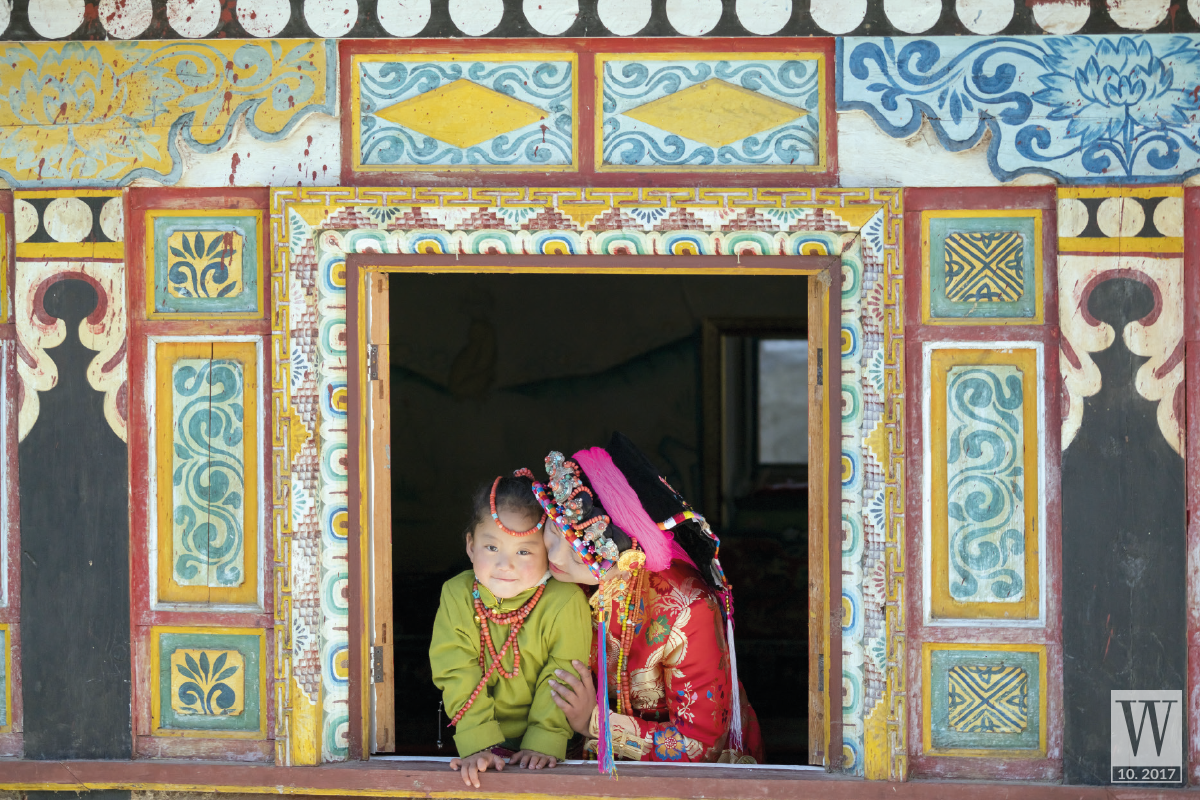
Looking at the rows of pilgrims from all walks of life practising one step, one bow or three steps, one bow on the way to Jokhang Temple, you will realise how sacred it is. Jokhang was built in the 7th century under the reign of Songtsen Gampo.
Situated in the bustling area of Barkhor, the Jokhang Temple was built and followed Tantric Buddhism, a branch of Vajrayana Buddhism. At the beginning, the Jokhang Temple worshiped Shakyamuni Buddha statue which the Princess Bhrikuti Devi (Nepalese wife of Songtsen Gampo) brought to Tibet when she got married to the king, while Jowo Rinpoche statue brought from China by Princess Wencheng (niece of Emperor Taizong of Tang) when she got married to Songtsen Gampo was worshiped at another temple. During the Cultural Revolution, the Shakyamuni Buddha was destroyed, and thus the statue Jowo Rinpoche was transferred to the Jokhang Temple.
Besides the rare famous Buddha statue of Jowo Rinpoche, the Jokhang Temple also worshiped thousands of other large Buddha statues, such as the Kshitigarbha, and the Tsongkhapa. In addition, it is said that all the wood carvings on the ground floor, the second floor and on the rooftop were made by Songtsen Gampo in the 7th century. And the pagoda also preserved the stone pedsetal Princess Wencheng often sat on. These items are considered treasures of Tibet. The bustling quarter of Barkhor is about 400 metres long, surrounding The Jokhang Temple, with many shops selling souvenirs and gems, but most of them are made in China. At the corner of the street, there is a very nice shop, Maykye Ame, in English it means Pretty Woman, it is where the 6th Dalai Lama spent the night talking about life and Buddhism.
SERA MONASTERY
Sera Monastery is the second largest one in Tibet. Among the huge monasteries of Lhasa, Sera Monastery is the nearest to the Potala, and you will see the White and Red Palace under the blue sky of Tibet when standing in the yard of Sera’s main hall. In the monastery, there are two Buddha statues, including a large male Buddha and a small female Buddha being held in the male Buddha’s arms. At first glance, people often misunderstand and think it is a profane representation. But in fact, the male represents the Widsom, the female symbolizes Kind-Heartedness. It means that in a human being there is always Wisdom and Kind-Heartedness, like a yin-yang balance.
Behind the monastery, there are many large stone blocks like the 8 auspicious symbols of Buddha. It is used as a place to perform the funeral rituals in which bodies are chopped up and fed to the vultures. The Tibetans believe there is no need to preserve the body, as it is now an empty vessel. It means to unite the deceased person with the sky. Previously, foreigners were allowed to observe this ritual but later the Tibetan government banned it.
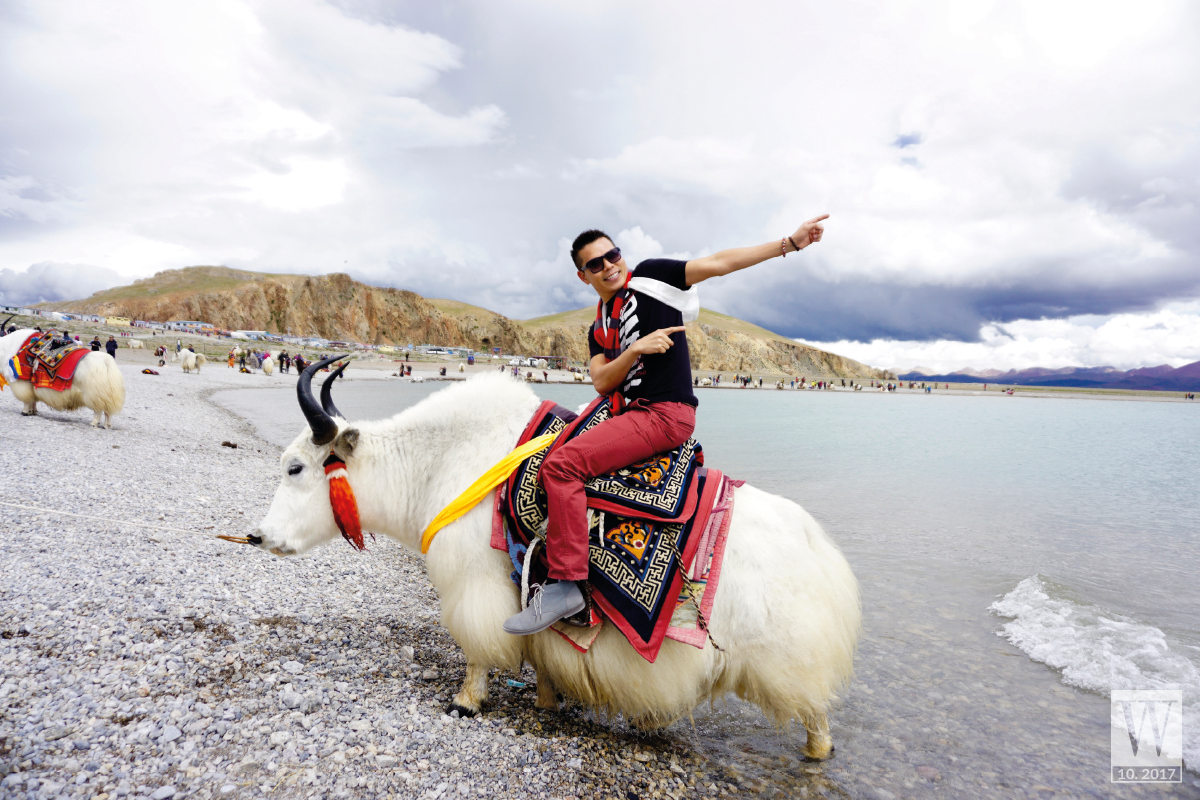
FROM SHIGATSE TOEVEREST BASE CAMP
Leaving Lhasa, I followed the 5,000 kilometre National Highway 318, the longest and highest road in the world that stretches from Shanghai to Nepal, to Shigatse – Tibet’s second largest city located at an altitude of 3,800 metres with 600,000 people to get closer to Mount Everest.
If Lhasa was the city of the Dalai Lama, Shigatse is the city of the Panchen Lama – monks in the monasteries, teachers of the young Dalai Lama and the persons responsible for the incarnation of the Dalai Lama. Between two generations of Dalai Lama there is usually a gap, so Tibet will be ruled by the Panchen Lama. So far, Tibet has eleven Panchen Lama, in which the 11th is very young at the age of 27 and is studying in Beijing, so he still travels between the two cities. About six hours after leaving Shigatse and following National Highway 318, we arrived at Old Tingri Town. Located at an altitude of 4,300 metres, it is about 100 kilometres from the Everest Base Camp. Compared to Shigatse, it is situated at a much higher altitude and the road conditions were bad, so I easily became exhausted.
The Qi Mo Lang Ma is the best hotel in Tingri Town. We stayed at a comfortable hotel with a bathtub, hot water and warm air conditioning, but unlike regular hotels elsewhere there are only shared toilets, and we had to walk to the toilets in the freezing cold at midnight.45 minutes after clearing the passport checkpoint, the dawn began to break. From the distance, we saw the 8,848-metre high Everest standing proudly under the sky in the early morning. When we arrived at an empty road about 20 kilometres from Everest, the driver decided to stop the car for taking photos and said that we were very lucky because there was only 10 per cent chance of Mount Everest in the clear sky.
Then we continued the journey. At 8:30am, I arrived at the transit station to take a smaller vehicle to climb to the Chomolungma landmark at 5,200 metres. The temperature was 8-10°C, so I wore warm clothes, scarf and gloves. At this time, first rays of morning sun appeared in the sky (note that Tibet has four seasons in one day, in the morning, it is often very cloudy, the sun often comes out at midday). Continuing our climb to another hill, after about 10 minutes, we arrived at the best viewpoint in Nepal to see Mount Everest!
We experienced profound tiredness when travelling by car, lack of sleep at night, shortness of breath, headaches and dizziness, but our unbound emotion was that of joy and two hours of watching Everest elapsed so fast it seemed as a song of memories.
Tibet not only offers travellers Lama and Everest, on the way back, we also visited many other impressive places including Karuola Pass. It is famous for being the closest spot to the glacier, so close that we could observe it with the naked eye. Over time, along with climate change, the ice at the foot of the mountain has melted away, but millions of years ago the entire mountain range was covered with snow and ice. The stop is at a height of more than 5,000 metres, while the peak is at more than 7,000 metres.
After more than 1 hour driving, we arrived at the Yamdrok Lake, one of the four sacred lakes in Tibet, it is naturaly shaped like a scorpion, surrounded by many snow-capped mountains. According to legend, Yamdok Yumtso lake is the transformation of a goddess. The lake, also known as Coral Lake, is probably named after its mysterious blue watercolor. From above, it looks the most beautiful. As you climb down to the lake you will feel very relaxed, calm and peaceful. With only CNY 10, you can take photographs with a Tibetan mastiff or domestic yak by the lakeside. In the winter, Yamdrok is completely frozen, so to enjoy its full beauty; you should go in the summer.Also on the way back to Lhasa the majestic mountain scenery will overwhelm you with white clouds floating in the blue sky contrasted by brilliant yellow cabbage flowers and ruby red or purple wild flowers by the riverside at the bottom of the mountain.
Despite my many new journeys ahead, Tibet will always stay in my heart, simply because it gave me so many diverse and distintive memories, from its history, to the beliefs and customs, to the spectacular mountain views and brightly colored floral displays.We said goodbye to Tibet in a sudden heavy rain that led to an extreme drop in temperature, but we were happy to know that, for the people here, the rain brings good luck and prosperity.
W.TIPS
BEST TIME TO VISIT TIBET
From April to October, summer weather is most favourable for sightseeing. In which, August and September are the most beautiful time offering lots of sunshine. Sometimes it rains in the evening and morning, purifying the air and green plants.
VISA
Due to the military conflicts here, Vietnamese travellers are required to travel in groups when entering Tibet. Moreover, after obtaining a Chinese visa, you have to get another special license to enter Tibet. Therefore, the first thing is to seek opportunities to go in group, and you should let the tour operator take care of the procedures.
TRANSPORTATION
From Vietnam, there are no direct flights to Lhasa, so you must transit in Chengdu or Kunming depending on the flight schedule. In Tibet, you will visit tourist attractions by tour bus. And it is recommended to wear comfortable sneakers.
HOW TO STAY HEALTHY
The average altitude in Tibet is about 4,000 metres. The greatest risks are altitude sickness, dyspnoea, and even breathlessness in an extremely thin atmosphere. Those who have problems with blood pressure, cardiovascular disease must consult their doctor before deciding to go. Healthy people should also be prepared with medication used to treat altitude sickness (acetazolamide 250mg, 1 tablet twice daily), antipyretics, saline nasal spray, vitamins etc.
WEATHER
Tibet has four seasons in one day. In the summer, it is very sunny after 11am, so you only need to wear summer clothes. In the afternoon, it will be windy and a bit cold, and then at night it may be very cold, so you need to prepare a hooded sweatshirt, a thick jacket, a woollen cap, and gloves. Early in the morning, you only need a seamless down coat and a scarf. If you visit Tibet in other seasons, it is a must to check the weather to prepare appropriate clothes. The weather is very dry, so you need to prepare sunscreen, lotion, sunglasses and wide-brimmed hat.
CUISINE
Tibetan food itself is very rarely spicy, certainly not as spicy as Sichuan food, and definitely not as greasy as Chinese food. Nonetheless, it is still not easy to eat. The effects of tiredness when you travel around a lot, altitude sickness, and lack of sleep can cause loss of appetite. Vietnamese should bring dry food just in case you do not like Tibetan food.
The traditional beverage of Tibet is butter tea. Butter tea has a milky colour and an unpleasant smell and not so enjoyable when tasting for the first time. It is useful to the Tibetan people because it provides a relatively high amount of energy, helping people stay warm and work under the harsh conditions of Tibet. Tibet also has many baked goods to choose from, but due to the different spices some people may not like them.
HOTELS
In large cities like Lhasa and Shigatse, there are many options, but in the small provinces and towns, you can only find low-level accommodation options. Hotel breakfasts are also very simple. In general, the offerings here are not as good as other tourist cities.
ENTERTAINMENT
♦ At night, Lhasa’s city centre is bustling with cafes and bars.
♦ If you have time, Wencheng Princess show of famous director Zhang Yimou is a good choice for a night out.
SHOPPING
♦ Tibet is famous for gemstones, including Dzi beads, agate, turquoise, etc. Only large certifiied stores have quality gems and artificial gemstones can be bought at any tourist shop.
♦ Your time in Tibet will be an opportunity to show your bargaining skills, because the Tibetans often overcharge. You should pay about 20-30% of the price they first state.
TOTAL COST
If you only visit Lhasa and Shigatse, the cost of travelling for a 10-day 9-night trip (staying in 3-star hotel) is about VND35 million And you will be charged VND5 million for visiting Everest Base Camp.
OTHER NOTES
♦ It is nearly impossible to communicate in English with hotel staff as well as indigenous people.
♦ The wireless signal is generally weak, and it is very hard to connect to the internet. Facebook, Gmail is blocked so you must use free VPN software like Betternet or VPN Master, but the wireless connection is still very unstable.
♦ One thing that cannot be overlooked is the public toilet system. Perhaps this is the worst aspect. The stinky toilets are terrible; and sanitation caretakers charge users but do not clean the toilets regularly and leave them dirty for reasons of water scarcity.
Tran Thai Duy | Wanderlust Tips


[…] the main streets of Lhasa, from 5am, you can see many people going to Jokhang to pray or performing a Kora – making a […]